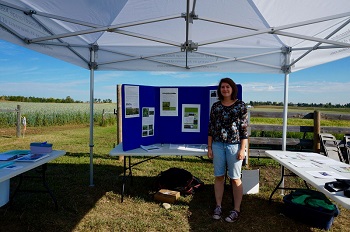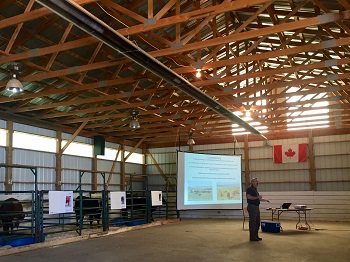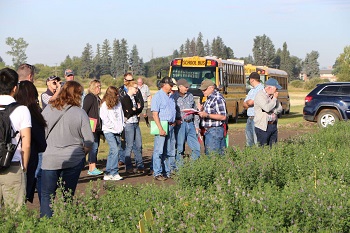The Banff Pork Seminar is a technology transfer meeting for the pork industry. The conference program is coordinated by the Department of Agricultural, Food & Nutritional Science, University of Alberta, Alberta Pork, Alberta Agriculture and Forestry and other industry representatives. Two Gentec students attended this year, and provided the following reports.
Xuechun Bai
As a first-year graduate student, it was a great opportunity and experience for me to attend the 2018 edition. It was a great honour to present our project, share the idea of our next steps and network with lots of people. The valuable suggestions and feedback they provided will help us improve and develop our project. I was also a volunteer at the event. Although sometimes tiring, it definitely worthwhile to support attendees in this way and see people enjoy the event.
I was most interested in the newest innovations in the pig industry, which introduced some automation technologies that can improve the biosecurity, efficiency and precision of farm management (see more below). The session on swine health and antibiotics, which indicated the trend of raising pigs without antibiotics, was also impressive. It highlighted the importance of improving herd health by making genetic improvements and inspired us to study and work harder as part of Gentec.
Greg Peterson, one of the Peterson Farm Brothers presented the closing plenary in an interesting and innovative way by singing to advocate agriculture and their farm (they also produce entertaining and educational videos on their YouTube channel, some videos are parodies of popular songs and some are vlogs of their farming practices). I think it is really impressive to encourage young people to be more creative and use new methods such as social media to advertise modern agriculture and educate the public on research and the future of agriculture.
I hope I can attend the Seminar next year again, when I will be able to share and present more results and progress of my study.
Ziqi Yang
The ultimate goal of our livestock research studies is to feed the world and improve the quality of animal protein products. In terms of feeding the world, the plenary session provided a good opportunity to understand more about the agricultural economy.
Dr. Larry Martin spoke about “Using Futures & Options to Manage Price Volatility.” He said, “We constantly have a ‘bull bag’ and a ‘bear bag’ of things to consider; that’s what makes a market.” (A bull thrusts its horns up, while a bear swipes its paws downward. These actions are metaphors for the movement of a market. If the trend is down, it’s a bear market.) He explained several chart formations (Stylized Resistance and Support at Contract Highs and Lows) that producers can use to help them know price trends to decide where prices are going and what actions they should take to reduce losses. Essentially, he asked the audience to reframe the question they ask themselves: not “What do I think these hog prices are going to do?” but “As prices change, where do I take action and what action should I take?”
In a similar vein, Ron Plain talked about the “Hog Market Outlook and Pricing Methods.” Although ethanol production led to very high grain prices, causing financial stress for livestock producers in 2006-2013 and PED virus pushed 2014 hog prices to record highs, hog numbers have increased and prices have decreased. The world trade in pork is fairly stable with slight increases in the last few years, which are expected to continue.
In the session on “Personality Typing and Profiling: Effectively Communicating and Working with Various Personalities,” Trish Hyshka helped the audience do the Myers-Briggs personality test, categorizing themselves according to the four main types: “Artisan”, “Rational”, “Idealist” and “Guardian.” She illustrated how the performance and preferences of these personality types differ. Knowing more about your stakeholders’ personality (group or individual) can help determine how to work with them and get optimal results even if you are not in a position of authority. The theory sounds good but, based on my results, the results may not be applicable to everyone. I would prefer to discuss the theory’s applicability with my peers before putting it into practice, or find a course that takes the headline farther.
The Swine Health and Antibiotics session had three speakers. Egan Brockhoff introduced the recent antibiotics guidelines changes to reduce antimicrobial resistance, which include:
- – removing growth promotion claims from medically important antimicrobials (MIAs),
- – increasing oversight on importing veterinary drugs,
- – increasing oversight on the importation and quality of active pharmaceutical ingredients,
- – mandatory reporting of sales volume from manufacturers and importers to support antimicrobial use surveillance,
- – facilitating access to low-risk veterinary health products as additional tools for animal health and welfare, and
- – increasing veterinary oversight over all MIAs.
Clayton Johnson mentioned that animals raised without antibiotics would reduce average daily gain, average daily feed intake, caloric conversion efficiency and increase morbidity and mortality, especially for nursery pigs. Greg Wideman had some good suggestions on reducing these negative impacts, including measurement and review of biological and economic performance, elimination and control of critical diseases, etc. My research on resilience would be another approach.
Steve Savage gave high marks to the performance of global feed production over the past several decades in “The Future of Agriculture: Challenges, Threats, Barriers and Opportunities.” however, if performance is going to increase even more in the future, different growers and producers in the agricultural sector will have to collaborate on creative strategies, such as setting up an independent certification system, to meet increasing demand and reduce the environmental challenges.
In the Newest Innovations session, Lee Whittington shared some technologies for improving pork farm management and production, such as satellite syndromic health surveillance and DrySist cleaning/baking process. Frédéric Fortin, from CDPQ (Quebec Pork Development Centre), introduced three new technologies (individual water intake recording system, infrared thermography and weight and conformation evaluation vision systems) used in the test station to provide faster more accurate data.
The water intake recording system is being used in our pig resilience project with Fred. Since water intake changes before symptoms of disease appear, it may be another health status index for producers to monitor. As well, pig body temperature usually increases after infection, for example from 39.3 °C to 40.2 °C in a single day after PRRSV infection. (Rossow, Kurt D., et al., 1994) Infrared thermography could monitor body temperature and pig movement in real time without handling but the current price (over $10,000) makes it expensive to apply in this way. Vision systems can also view pig movement with a tracking system and create 3D pictures from which to calculate a pig’s weight in the pen. However, since the pig needs to be alone in the pen for the 3D photo, it provides no advantage over traditional weighing methods. It is exciting to be involved in a project that introduces these new technologies as part of our research. This was one of the rewarding aspects of working at the test station for several weeks, as well as learning exactly how the project works at the action end.
Rossow, Kurt D., et al. “Experimental porcine reproductive and respiratory syndrome virus infection in one-, four-, and 10-week-old pigs.” Journal of Veterinary Diagnostic Investigation 6.1 (1994): 3-12.
To read the official proceedings, click here.





